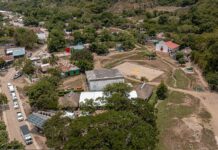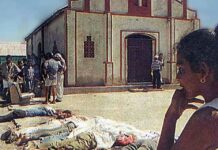Overcrowding, drug abuse and unhygienic living conditions are rife in Colombia’s prisons. As the situation reaches crisis levels The Bogota Post investigates…
Riohacha is a coastal town on the northern coast of Colombia, home to nearly 140,000 people, and a steady year-round flow of tourists. The centre of town is filled with colonial architecture and palm trees lining the promenade. You could be forgiven for thinking that this is yet another Colombian paradise. However, beneath the serenity lies a darker reality – Riohacha prison.

Built in 1935 to hold a maximum of 100 prisoners, it is currently estimated to be experiencing overcrowding levels of 438 percent. Riohacha is just one example of a country-wide prison overcrowding crisis. The 142 prisons in Colombia have been built to hold approximately 37,000 people. Yet recent estimates put the actual number of prisoners at a whopping 118,000.
Late last month, Colombia’s Ombudsman Jorge Armando Otalora requested that the national government declare a state of emergency in response to the conditions and ongoing strikes by prison guards. He said in a statement on August 25: “We cannot talk about reconciliation and processes of peace on the one hand, when we are mistreating and ignoring the rights of human beings on the other.”
In response, the government announced plans to fight overcrowding by expanding and building additions to nine of Colombia’s prisons. The program is set to create 6,300 new cells by the end of 2018, officials said.
Some action has already been taken to address the problems associated with overcrowding. Late last last year, some 7,000 to 9,000 prisoners were let out of Colombia’s prisons as correctional authorities attempted to relieve the overwhelming number of inmates. Criminals who were locked up for “minor” crimes, or who are serving terms of less than eight years were eligible, and those released were allowed to serve the remainder of their sentences from home. Those made eligible included people found guilty of minor assaults, domestic violence, child neglect, scamming people for less than 30 million pesos, and property damage.
In prisons worldwide, inmates have expressed their frustration at the boredom, isolation and monotony of life ‘on the inside’. These problems hold true for Colombia, with the additional issues of overcrowding, health care neglect and rampant drug addiction.
Speaking to The Bogota Post about their experience working in La Picota (one of Bogota’s biggest prisons), an NGO worker who wished to remain anonymous said: “The system here works on a merit basis, if you have money or access to resources, then you will be able to secure your own safety and anything from the most basic necessities to luxuries that you would struggle to even find on the outside. But we have to remember that the huge majority do not have access to these funds and those are the ones who really suffer.”
| “We are sometimes obliged to transfer 40 to 50 inmates in the presence of 10 to 12 guards; the minimum security recommendation is one guard per inmate.” – Nelson Barreras Morales, president of the prison guard trade union SEUP |
James Jordan, a coordinator at the NGO Alliance for Global Justice, said: “I’m closely following the issue of healthcare neglect – it’s an epidemic, and does not seem to have improved at all.”
According to Gloria Silva, a lawyer for the group Committee for Solidarity with Political Prisoners, the lack of basic necessities like water is also a serious problem. She says the dearth of a permanent water supply is an ongoing problem in many Colombian prisons. The lawyer added that this water shortage often results in health issues, as staff are unable to properly prepare food and inmates find it difficult to keep clean. In March this year, it was reported that Valledupar prison would have to be evacuated due to a lack of drinking water.
Hygiene issues are not the only problem brought on by overcrowding; the high number of prisoners per guard means that the use of illegal substances is often overlooked.
Not enough people know or even care about the desperation of Colombian prisoners. Gisela Parra, whose husband Jose was sentenced to three years’ imprisonment in La Modelo in Bogota for weapons possession, said: “The problem is that among many people there is little empathy towards prisoners.”
| “The problem is that (prisoners) go inside for small things, insignificant things, and the life inside makes them so much worse than before. They change to survive. Then the change becomes them.” – Gisela Parra, 35, whose husband is incarcerated |
Why then, has the problem suddenly attracted the attention of the Colombian media? Recent strikes by more than 1,000 of the National Penitentiary and Prison Institute (INPEC) prison guards have put the spotlight on the problems of overcrowding, violence and poor conditions – not only for inmates but for prison workers as well.
Many prison guards are refusing to return to work until they are promised that no more inmates will be received in facilities which are already between 20 percent and 400 percent overcrowded.
Nelson Barreras Morales, president of the prison guard trade union (SEUP), explained just how dangerous the situation is for all concerned. “We are sometimes obliged to transfer 40 to 50 inmates in the presence of 10 to 12 guards; the minimum security recommendation is one guard per inmate.”
His security fears came true in August, when prisoners in Santa Marta’s jail – which exceeds maximum capacity by 300 percent – rioted and attempted to take over, killing one prisoner and leaving 11 injured. And earlier this year, fires in overcrowded prisons in Barranquilla killed 23 people.
For his part, Mr. Jordan from Alliance for Global Justice believes the solution is not to build more prisons, but to incarcerate less people. He says, “One of the calls is to decrease the prison population by 20 percent. I don’t see any reason why that can’t be done. The prisons are full of people who haven’t been sentenced yet, people who have committed non-violent crimes such as protests.”
For many, the solution is even more elusive, as they believe the system itself is flawed.
“Prison in Colombia is not rehabilitatory,” the NGO worker told us.
Parra agrees: “The problem is that (prisoners) go inside for small things, insignificant things, and life inside makes them so much worse than before. They change to survive. Then the change becomes them.”













